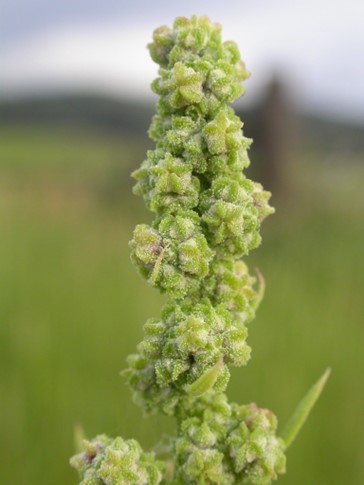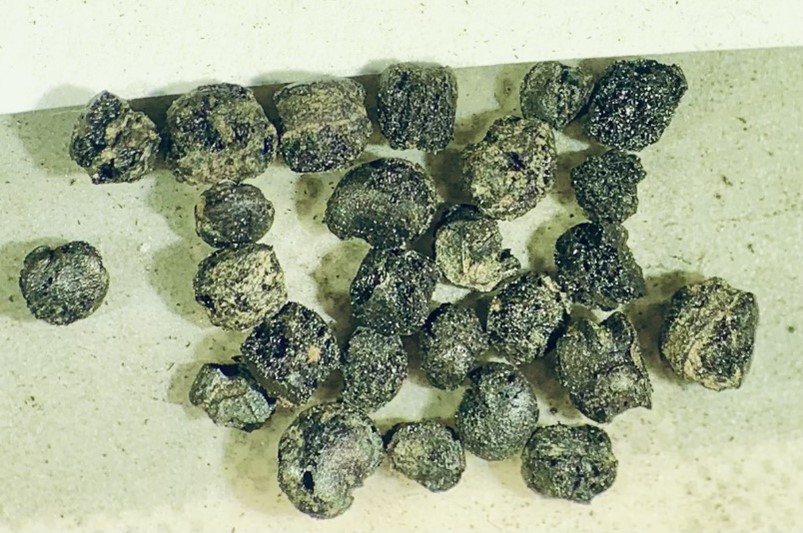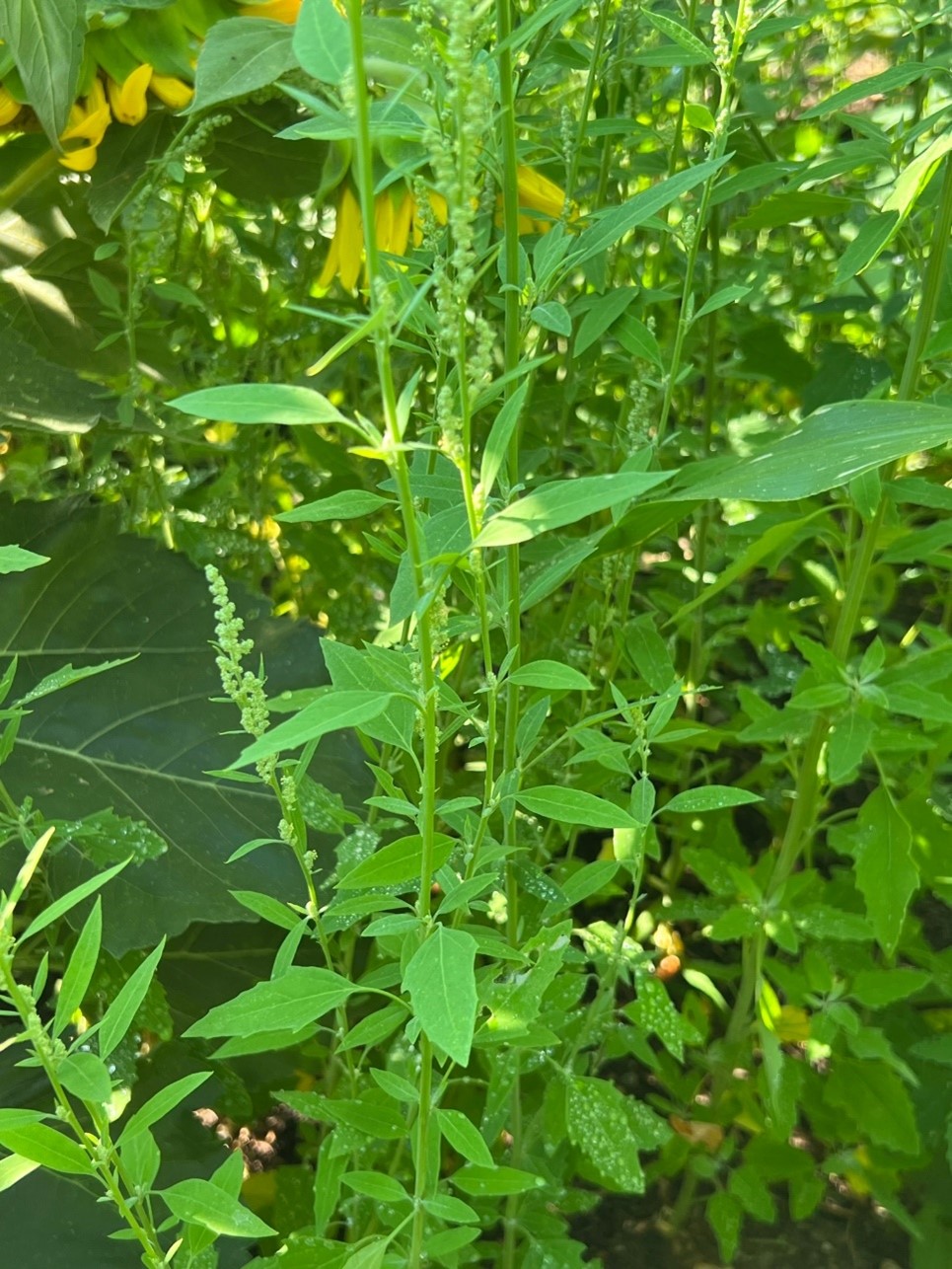You are most likely familiar with the plant quinoa, an ancient grain domesticated in South America, but have you heard of its North American kin, chenopod? Often considered a weed, this ancestral grain once played a major role in Indigenous diets, and some Indigenous chefs such as Nico Albert (member of the Cherokee Nation) are working to bring the grain back into indigenous dishes! (You can read more about Nico Albert’s work in this Atlas Obscura article.)

Figure 1. “Chenopodium berlandieri” by Matt Lavin (CC BY-SA 2.0).
Characteristics:
An herbaceous annual, chenopod prefers disturbed habitats with full sunlight exposure, which is why it is so often considered a weed and an annoyance in commercial agricultural fields. Yet, like many other plants that we today consider to be “weeds”, this plant has high nutritional value and was once an ancient crop.
Chenopod belongs to the plant subfamily Chenopodiaceae, of the family Amaranthaceae (Amaranth). This subfamily is also referred to as the “Goosefoot Subfamily” because the leaves of the plants are similar in shape to a goose’s foot (Figure 2). Spinach (Spinacia), lamb’s quarters (Chenopodium album), and the aforementioned quinoa (Chenopodium quinoa) are other plants that belong to this subfamily. Most of the Goosefoot plants have edible leaves and are often used as potherbs, as well as contain edible seeds. In general, the subfamily’s plants also contain globby or prickly flowers. Chenopod germinates in the spring and produces its fruit between June and October. The seeds themselves fall from the plant, possibly also dispersed by wind and/or animals.
![Figure 2. See how the leaf looks like a goose’s foot? (“Chenopodium berlandieri (3767483349)” by Matt Lavin [CC BY-SA 2.0]).](https://mcclungmuseum.utk.edu/wp-content/uploads/sites/78/2023/10/Fig2_chenopodleaf.jpg)
Figure 2. See how the leaf looks like a goose’s foot? (“Chenopodium berlandieri (3767483349)” by Matt Lavin [CC BY-SA 2.0]).
Carbonized chenopod seeds have been recovered from sites in the US Midsouth as early as 12,000 years ago (Figure 3). The gathering of these wild plants over millennia led to their domestication and use as a crop. But this would not have happened without great care, including storage of the seeds over winter and management to enhance the yield, such as preparing a seed bed and pulling unwanted competitors (weeds!). Along with chenopod, farmers – mostly women – grew and used other Indigenous crops such as sunflower, sumpweed, knotweed, maygrass, and little barley. These seeds have all been recovered within paleoethnobotanical samples from archaeological sites, especially in the Midsouth and what is considered the “Eastern Woodlands,” beginning around the Late Archaic period, or 4000 years ago. Indigenous people gathered both wild and cultivated forms, sometimes exclusively of one another. The decline of chenopod was due more to the disruption and displacement of Indigenous peoples after European contact around 500 years ago, more so than the rise of maize agriculture around 1000 years ago. However, some cultivars of chenopod are still grown throughout Mesoamerica and the US Southwest.
Referred to as a grain, the seeds of chenopod are a significant source of carbohydrates and would have been gathered in late summer and early fall to both replenish the past spring stores and to store for the upcoming winter months. Processing of the seeds to remove the seed coat before cooking would have been time-costly, given how small the seeds are (1-2 mm in diameter).

Figure 3. Carbonized cultivated chenopod from archaeological site Magic Waters (31JK291) in Cherokee, North Carolina, dating to the Middle Woodland time period (ca. AD 100-300; photo by Kelly Santana).
UTK’s Foodways Garden:
Wanting to see chenopod (and other wonderful and historical foodways plants!) in person? Check out the Foodways Garden planted by UTK’s Paleoethnobotanist, Dr. Kandi Hollenbach, just outside of Strong Hall!

Figure 4. Chenopod growing in the UTK Foodways Garden outside of Strong Hall (photo by Kandi Hollenbach).
For More Information:
Elpel, Thomas J. 1967. Botany in a Day: The Patterns Method of Plant Identification, An Herbal Field Guide to Plant Families of North America. HOPS Press. Pony, MT.
Gremillion, Kristen J. 2014. “Goosefoot (Chenopodium”, in New Lives for Ancient and Extinct Crops. Edited by Paul E. Minnis. Pages 44-64. The University of Arizona Press.
Moerman, Daniel E. 1998. Native American Ethnobotany. Timber Press, Portland, Oregon.
NC State Extension Gardener Plant Toolbox. https://plants.ces.ncsu.edu/plants/allium-tricoccum/.
Scarry, C. Margaret. 2003. “Patterns of Wild Plant Utilization in the Prehistoric Eastern Woodlands”, in People and Plants: In Ancient Eastern North America. Edited by Paul E. Minnis. Pages 50-104. Smithsonian Institution.
US Department of Agriculture, Natural Resources Conservation Service. 2021. PLANTS Database. Electronic document, https://plants.usda.gov/home.